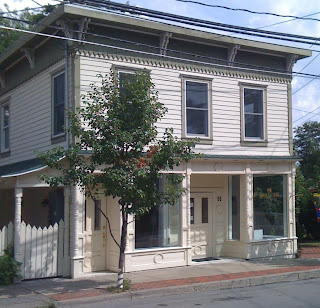Kurt Moyer
"Frost Pond", oil on linen
With so much rain during this summer, my garden is lush but gets out of hand if I don't give it constant attention. I like to be outdoors and think about how artists' portrayals of nature have helped form my personal aesthetic. Childhood memories include my father packing art supplies on family vacations so we could paint on location.
Great art will stand the test of time. Some subjects (like landscape) may never go entirely out of fashion, it just seems as though some artists' styles get dated. Style is more about what you leave out of a painting; and style also has to do with how an artist structures space in a painting.
If you go outside to paint (en plein aire) - how do you begin to comprehend nature in all its variety? If you can understand what you are seeing, how does that translate into color, shape, and atmosphere? How will you determine what is essential to your art? With that in mind we could begin to look at some paintings in recent exhibitions and have a view into the artists' modus operandi.
At the Arts & Cultural Council gallery on North Goodman Street in Rochester, we have bright new paintings from Kurt Moyer. Roughly divided into three sections, Kurt Moyer's paintings are figurative realism within a classical compass. Nude bathers, calm bosky ponds, and spring flowering are all handled with a painterly, not overly fussy, approach. It seems as if it is a perpetually sunny day in Kurt Moyer's world where people swing in a hammock, go sailing or cavort in the woods. Associations could be made with Manet and Cezanne - but seen through a more contemporary lens - so that these paintings are neither the transgressive fleeting nudity of Manet, nor the heroic near-abstractions of Cezanne. Kurt Moyer's matter-of-fact observations translate with joy and care for his subject.
Scale, the relative size of things, becomes a critical factor in landscape painting - it helps or hinders our "reading" of the artwork and can render a painting more or less chaotic if the artist is not sensitive to it. What is painted with clarity and what is not becomes an issue to be addressed. In photography it is the focal point and the sharpness of edges relative to lighting that can determine how we respond to a scene. Something similar happens in painting.
Windsor Whip Works Art Gallery
Just outside the city boundaries of Binghamton is the village of Windsor, and on Main Street a beautifully renovated store has now become the two story Windsor Whip Works Art Gallery. Bill and Johanne Pesce migrated up from Long Island to create this art center which is becoming a magnet for visitors and artists alike. On a recent weekend, I met George Rhoads at the opening of a show of more than one hundred of his imaginative landscape paintings.
In the 1960's George Rhoads had shows in New York City of his expressionist paintings, but he is known more for his kinetic sculptural installations found in many museums and in collections around the world. Rhoads was educated in Chicago and has been an artworld presence for over fifty years. Curiously, only one or two of his sculptural works were on hand at the Whip Works Art Gallery, and the rest of the space was given over to his and his son Paul's paintings.
The mostly smallish size of the paintings does not mean that George Rhoads is a miniaturist, but it does mean that for the viewer to make the most of the experience- you have to get very close to fully enjoy the work. A typical George Rhoads landscape has a quality that folk art seems to share - unusual brightness of color and unusual clarity in places that make the reading of the work more structured and more uniform than would happen in nature. George Rhoads does not paint on the scene, these are more memories or evocations of places, and at their best they are knit together like a fascinating quilt of color and texture.
George Rhoads
at Windsor Whip Works Art Gallery



